India’s swift and focused retaliation under Operation Sindoor forced Pakistan into a ceasefire plea within hours, reveals top military official
Pakistan aimed to bring India to its knees in 48 hours. Instead, its offensive folded within eight, prompting a rushed request for talks. That’s the blunt message India’s Chief of Defence Staff, General Anil Chauhan, delivered on Tuesday during a lecture on modern warfare in Pune.
Speaking at Savitribai Phule Pune University, General Chauhan gave a rare glimpse into the timeline and tactics of the latest military standoff between India and Pakistan, revealing new details about Operation Sindoor and Pakistan’s failed campaign called Operation Bunyan al-Marsoos.
What Happened on the Night of May 10?
The confrontation began in the dead of night.
“On May 10th, at around 1 am, Pakistan launched multiple attacks,” General Chauhan said. “Their stated goal was to cripple India within 48 hours.”
Instead, they were met with a rapid and targeted Indian response. Operation Sindoor wasn’t just a counter; it was a clear signal of preparedness and strategic precision.
“They escalated the conflict, despite India only targeting terror launchpads,” Chauhan added.
The timeline is telling. Within just 8 hours, Pakistan reportedly found itself overwhelmed. The offensive, meant to last two days, barely lasted through breakfast. And by the end of the day, Islamabad was reaching out, not firing shots.

What Was Operation Bunyan al-Marsoos?
Details of Pakistan’s operation were mostly unknown—until now.
According to Chauhan, Operation Bunyan al-Marsoos was designed to shock India with a barrage of simultaneous attacks. The goal? Quick escalation and a perception of military dominance.
It didn’t go as planned.
Here’s what Pakistan intended, based on intel and Chauhan’s statements:
-
Surprise cross-border attacks at night
-
Infrastructure disruption in border areas
-
Amplification of propaganda via social media
-
Possible cyber interference targeting Indian installations
But India’s pre-positioned response, honed over years of intelligence and tactical recalibration, neutralized the threat.
Operation Sindoor: India’s Calculated Response
India’s reply—Operation Sindoor—was surgical and tightly focused. It didn’t spiral into full-blown war, but it made a strong point.
Unlike previous conflicts that dragged on for days or weeks, this was different.
One Indian official, on condition of anonymity, called it “quick-fire dominance.”
India’s goal was clear: no overreach, just clean elimination of threats.
Bullet points from available information:
-
Strike duration: ~6 hours
-
Targets: Primarily terror launchpads near LoC
-
Civilian areas: Avoided deliberately
-
Ceasefire talks initiated by: Pakistan DGMO
Pakistan “was pleading” for an end to the military action, according to BJP spokesperson Shehzad Poonawalla.
Political Tempers Rise Over Mediation Claims
While the military outcome appears decisive, the political back-and-forth has turned messy.
Congress leader Rahul Gandhi accused the Modi government of “surrendering” and hinted that the U.S. mediated the ceasefire.
BJP, unsurprisingly, hit back hard. Poonawalla called Gandhi a “leader of Pakistani propaganda,” urging him to listen to senior Congress leaders like Shashi Tharoor and Salman Khurshid—both of whom denied any foreign mediation.
The Prime Minister’s Office and Ministry of External Affairs have categorically denied any role by Washington in halting the hostilities. According to official sources, it was Pakistan’s military establishment that reached out, not the other way around.
What India’s CDS Really Said—Word by Word
General Chauhan’s speech offered strategic clarity, not political drama.
“We had targeted only terror sites. They escalated. But once our retaliation kicked in, they backed off,” he said.
It wasn’t just about muscle. It was about speed, strategy, and sticking to the objective. He added that future wars will require “more precise, intelligence-driven responses” and that “short, sharp conflicts” will define modern military strategy.
Bigger Picture: Is Peace Any Closer?
Despite the calm that followed, things remain tense. Cross-border ceasefire violations have dropped, but trust is low. Experts believe Islamabad may test the waters again once domestic pressures mount.
But the outcome of this standoff has changed the tone.
India’s military message was loud and clear: it won’t wait to react, it’s already ready.
As for Pakistan, the embarrassment of such a swift fold may force it to rethink escalation as a tactic. But history shows such recalibrations don’t always last long.
